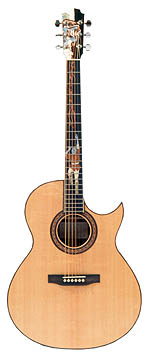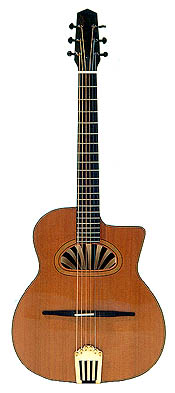
| Opus 27 Cutaway Steel-String Guitar |
|
|
On a cutaway guitar, the soundbox is curved where it meets the neck so that the guitarist's left hand can easily produce the high notes on the fingerboard. Although the cutaway did not become popular until after World War II, it was a distinctive trait of the famous guitars made in the late 1920s by Mario Maccaferri. The first cutaway acoustic guitar, with slightly cutaway side, appears to have been made by the American firm Gibson in 1918. Similar experiments had been carried out on classical guitars in the nineteenth century, but with no permanent results.
This guitar is striking in its beautiful craftsmanship. The decoration on the instrument's neck was inspired by the Grimm fairy tale Rapunzel. Beautiful Rapunzel's hair cascades down the fingerboard so that her lover can reach her, using the frets. This image is symbolic of the luthier's motto, "Reach for the top." It is magnificently rendered by delicate inlays, which are William Laskin's hallmark. Opus 28 Mario Maccaferri, an Italian born in 1899, was a classical guitarist, luthier and engineer. In the 1920s, he designed and produced for a French firm a prize archtop guitar, noted for its volume.
The Maccaferri guitar is associated with the famed guitarist Django Reinhardt. In addition to its characteristic D-shaped soundhole, cutaway side and sophisticated machine heads, the instrument features an interior soundbox, which is designed to resonate and amplify the treble frequencies, or " high end", of the guitar's sound. Michael Dunn has altered the original Maccaferri design in order to achieve maximum volume and tone. With its shell made of alternating strips of holly and ebony, the guitar can project high frequencies and thus produce greater volume; it is a more "orchestral" instrument, according to Dunn. The machine heads are the Grover Minis type. Like all of Michael Dunn's instruments, this guitar is beautifully crafted. It bears the number 244. |
 |




